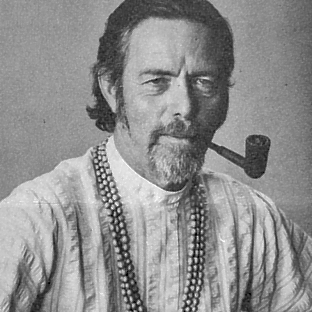
In his autobiography, In My Own Way(1972), Alan Watts writes of having a curious affinity with Japan even in his childhood. His early impressions were shaped by Lafcadio Hearn through Glimpses of Unfamiliar Japan (1894), and more substantially through Gleanings in Buddha-Fields (1897).
The first marriage of Watts to the daughter of Ruth Fuller Sasaki gave him an important link to Zen in which he took a strong philosophical interest, though his autobiography makes clear he was never a follower or practitioner. In all, he visited Japan four times and, unsurprisingly, was drawn to Kyoto as the heart of the country’s traditional and religious culture.
Interestingly Watts reserves his time in Kyoto for the very last chapter of his book, entitled ‘The Sound of Rain’. It’s indicative of how special the city was for him. Like Truman Capote, he notes the cheerful sound of the ever-present streams running through and under the city.
(The following four paragraphs are taken from pages 340-342 in the 2001 edition of his autobiography, published by the New World Library.)
*******************
But it was not only for Zen that I went immediately to Kyoto when I first arrived in Japan. I wanted to feel the everyday life of a city which had been soaked in Buddhism for so many centuries, not analyze it like a psychologist, categorize it like an anthropologist, or study its splendid monuments like an antiquarian. I went to gape like a yokel and simply absorb its atmosphere. We went to the district of Higashi-yama, or Eastern Hills, where buildings on narrow, winding streets overlook the rest of the city, which – unusually for Japan – are laid out in the flat grid pattern of an American city in a geographical setting which slightly resembles Los Angeles. Hills, even mountains, lie to the east, north, and west, while the south is open to Osaka, Kobe, and the sea. As in Los Angeles, the best land is in the foothills, where spring-water flows into garden pools through bamboo pipes, and though there are here many quiet and sumptuous private homes, much of the area has been occupied by temples and monasteries. Originally it belonged to feudal brigands, who were scared of the Zen priests because the priests weren’t scared of them, became pious Buddhists, and made generous offerings of land.
When one goes to a city like this it is all very well to make plans to see the famous sights, but there should be plenty of time to follow one’s nose, for it is through aimless wandering that the best things are found. We stayed in the ryokan, Japanese style inn, on the hill above the Miyako Hotel. To the north-west the sweeping grey-tiled roofs of the Nanzenji Zen temples float above dense clusters of pines, and to the southeast stands the huge cathedral of Chion-in, and all about are wayward cobbled lanes enclosed by roofed walls with covered gates, giving entrance to courtyards and gardens, and interspersed with small shops and restaurants. It was April and under such a gate we took refuge from a sudden shower. The door opened a few inches, and out came a hand proffering an umbrella, and as soon as we took it the hand was withdrawn and the gate closed. The umbrella was a kasa made of oiled paper– a wide circle spread out like a small roof supported on a cone of thin bamboo struts, almost as cozy as carrying your own house with you in a quiet, heavy rain. We returned it the next day.
Gutters were bubbling, and water was spilling from bronze, dragon-mouthed gargoyles at roof corners. Everywhere the soft clattering of wooden sandals like small benches with legs on the soles to keep your feet above water. courtyards with glistening evergreen bushes and floating branches of bright green maple. The smell of Japanese cooking – soy sauce and hot saké – mixed with damp earth and the faintest suggestion, pleasant in that small a dosage, of the benjo or toilet which, because of the diet, smells quite different from ours. Because I need a dictionary to read most Chinese characters the signs on shops are just complex abstract designs, or it seems to me that ‘Mr Matsuyama’s Cafeteria’ is the ‘Pine Mountain Harmonious House.’ going deeper in the city we found the long, busy lane of Teramachi, or Temple Street, to nose about in the higgledy-piggedly of tiny shops that sell utensils for tea ceremony, incense, ink, writing brushes, old Chinese books, fan, Buddhist bondieuserie, and huge mushrooms that should be wearing pants– the whole lane buzzing and rattling with motorcycles and diminutive Toyota taxis.
With sense of time gone awry from travel by jet, I wake at four in the morning to hear what is, for me, the most magical single sound that man has made. It comes from a bronze bell some eight feet high and five feet in diameter, struck by a horizontal swinging tree-trunk, and hung close to the ground, actually more like a gong than a bell. it doesn’t clang out through the sky like a church bell but booms along the ground with a note at once deep and sweet and vaguely sad, as if very very old. It sounds once and, when the hum has died away, again… and several times more. From the direction, I realize that this is the bell of the Nanzenji Zen monastery, signifying that, so long before sunrise, some twenty young men, skin-headed and black-robed, have begun to sit perfectly still in a quiet dark hall. When the bell finishes they will begin to intone, on a single note, the Shingyo, or Heart Sutra, which sums up everything that Buddhism has to say – ‘What is form that is emptiness, what is emptiness that is form.’ Actually the language is the Japanese way of pronouncing medieval Chinese, which hardly anyone understands, and the words are chanted for their sound rather than their meaning.
